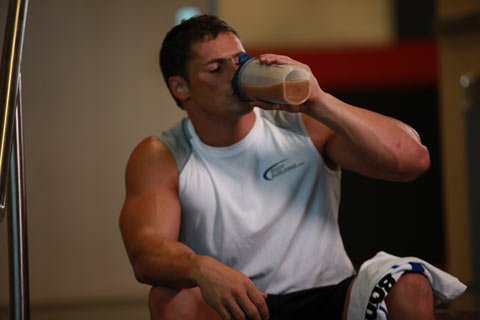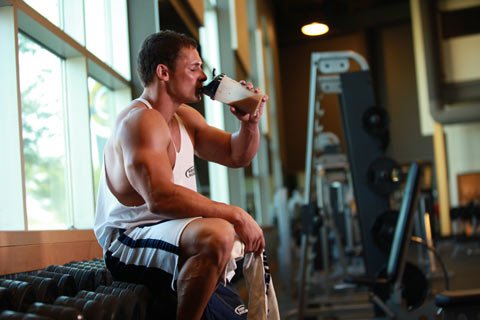In this age of complex nutrition supplementation, the basics of sport nutrition have been forgotten. Simply put, in order to gain mass one must stay in an anabolic (muscle-building) state. The off-season is the perfect time for an athlete to focus on strength gains and hypertrophy due to the reduced demands of skill training. Hypertrophy is an essential mechanism in the development of increased strength because in the most basic equation, larger muscles translate into greater strength.
The easiest way to ensure an anabolic response to resistance training is through a proper and consistent scheduling of nutritionally balanced meals. A post-workout drink, such as a commercial meal replacement supplement, is optimal for providing adequate amounts of both protein and carbohydrates to help fuel protein synthesis and to limit protein breakdown. In addition, a liquid supplement at this time meets the demand of increased fluid requirements and assists in enhancing the hydration level of the athlete.
The continuous delivery of high-quality calories will fuel muscle growth and recovery by supporting protein and glycogen synthesis. In opposition, periods of more than 3-4 hours without food can result in a post-absorptive catabolic state and this would be magnified in a post-workout environment. In a catabolic state, muscles are "broken down" for energy, essentially robbing you and your muscles of your previous growth accomplishments. Immediate post-workout energy consumption prevents a delay in the delivery of energy substrates to the depleted muscle cell and is therefore an important method to remain anabolic and in positive energy and nitrogen balance.

The Benefits
The benefits of the post-workout drink are regulated by the hormonal (insulin) response to food intake. Elevated insulin levels occur in response to carbohydrate intake and increase the muscle cell's uptake of glucose (carbohydrate) and amino acids used to synthesize glycogen and protein, respectively. Carbohydrates should not be omitted from the post-workout feeding because they allow the insulin levels to be elevated.
Exercise (muscular contractions) increases the cell's insulin sensitivity and results in a rapid transport of glucose into the cell.
Increased post-workout insulin levels are not detrimental and will not cause an increase in fat storage because the nutrients will be directed toward skeletal muscle at this time. Carbohydrate intake results in glycogen re-synthesis to replenish the fuel source for the next bout of resistance training (Ivy et al. 1988) and post-workout carbohydrate intake has been recommended as 0.7-1g/kg (Burke et al. 1996).
The highest rates of glycogen re-synthesis occur when carbohydrate is consumed within 2 hours of training (Ivy et al. 1988), therefore maximal recovery demands an immediate post-workout carbohydrate intake. Optimally, the carbohydrate would have a high-glycemic index as high-glycemic carbohydrates are rapidly absorbed into the bloodstream and delivered to waiting muscle cells (Burke et al. 1993). Adherence to this feeding schedule is crucial to athletes that have a second training session scheduled within 24 hours (i.e. athletes involved in tournament play) because it fosters the highest rates of energy replenishment (glycogen re-synthesis).
A convenient post-workout feeding is also necessary to reduce protein degradation and increase protein synthesis. Protein synthesis has been observed to increase 50% within 4 hours of training and is elevated by 109% within 24 hours (MacDougall et al. 1995). The recommended protein intake for active individuals is 1.2-1.4g/kg, although requirements may temporarily increase if the intensity or volume of activity is increased (Tarnopolsky et al. 1992). To assist in meeting these requirements, the post-workout feeding should incorporate about 10-20 grams of protein.
The initial post-workout period is also optimal for creatine supplementation. Muscular contractions increase the cellular sensitivity to insulin and provide for the rapid intra-cellular transport of creatine to replace stores diminished by training.
A post-exercise drink also prevents dehydration, a phenomenon that may be catabolic. A post-exercise drink or meal-replacement can contribute to the recommended intake of 10 cups of non-caffeinated fluids per day. Because there is no difference in the effectiveness of a liquid or solid food source for glycogen re-synthesis (Burke, 1996), a liquid meal-replacement appears to be most beneficial post-workout. Other factors demonstrate the superiority of meal-replacements over whole food in the post-exercise condition.

 Click To Enlarge.
Click To Enlarge. A Post-Exercise Drink Also Prevents
Dehydration, A Phenomenon That May Be Catabolic.

Why This Works
Often athletes are fatigued and do not have the energy to prepare food or a reduction in appetite may also occur following hard training, therefore it would be necessary to have a convenient liquid food-replacement present to replenish the depleted muscle energy stores. Finally, the access to food may be limited, especially when other priorities demand time and energy and limit the time the athlete has to return to work or home while still consuming adequate calories.
Individuals that often complain of the inability to gain weight simply do not consume enough calories. A large portion of the sedentary American population has mastered weight gain through inactivity and constant snacking. Although fat weight is not desired, this scenario can be applied to hard-gainers. Work hard, rest harder, and stay anabolic. Post-exercise supplementation is essential for enhancing the anabolic environment and limiting the potential for exercise-induced catabolism.
These extra calories are welcomed by the hard-gainer for use in growth and repair. The easiest and most effective method for increasing the consumption of high quality nutrients is through post-workout liquid feedings. These supplements are easy to digest and do not make one full, therefore allowing for the consumption of a second post-workout meal of whole-food approximately 2 hours after the training session.
Easy, on-the-go types of foods are optimal and enable busy athletes to perform their daily activities hassle free and without worry from the fear of going catabolic.
References
- Burke, L.M. (1996). Nutrition for post-exercise recovery. Aus. J. Sci. & Med. 29: 3-10.
- Burke, L.M., G.R. Collier, and M.Hargreaves. (1993). Muscle glycogen storage after prolongedexercise: effect of the glycemic index on carbohydrate feedings. J. App. Physiol.75: 1019-1023.
- Costell, D.L., D.D. Pascoe, W.J. Fink, R.A.Robergs, S.I. Barr, and D. Pearson. (1990). Impaired muscle glycogen re-synthesis after eccentric exercise. J. App. Physiol. 69: 46-50.
- Ivy, J.L., M.C. Lee, J.T. Brozinick, Jr.,and M.J. Reed. (1988). Muscle glycogen storage after different amounts of carbohydrate ingestion. J. App. Physiol. 65:2018-2023.
- MacDougall, J.D. et al. (1995). The time course for elevated muscle protein synthesis following heavy resistance exercise. Can. J. App. Physiol. 20: 480-486. 269:E309-315.
- Tarnopolsky, M. A., S. A. Atkinson, J. D. MacDougall, A Chesley, S. Phillips, and H. P. Schwarz.(1992). Evaluation of protein requirements for trained strength athletes. J.Appl. Physiol. 73: 1986-1995.

